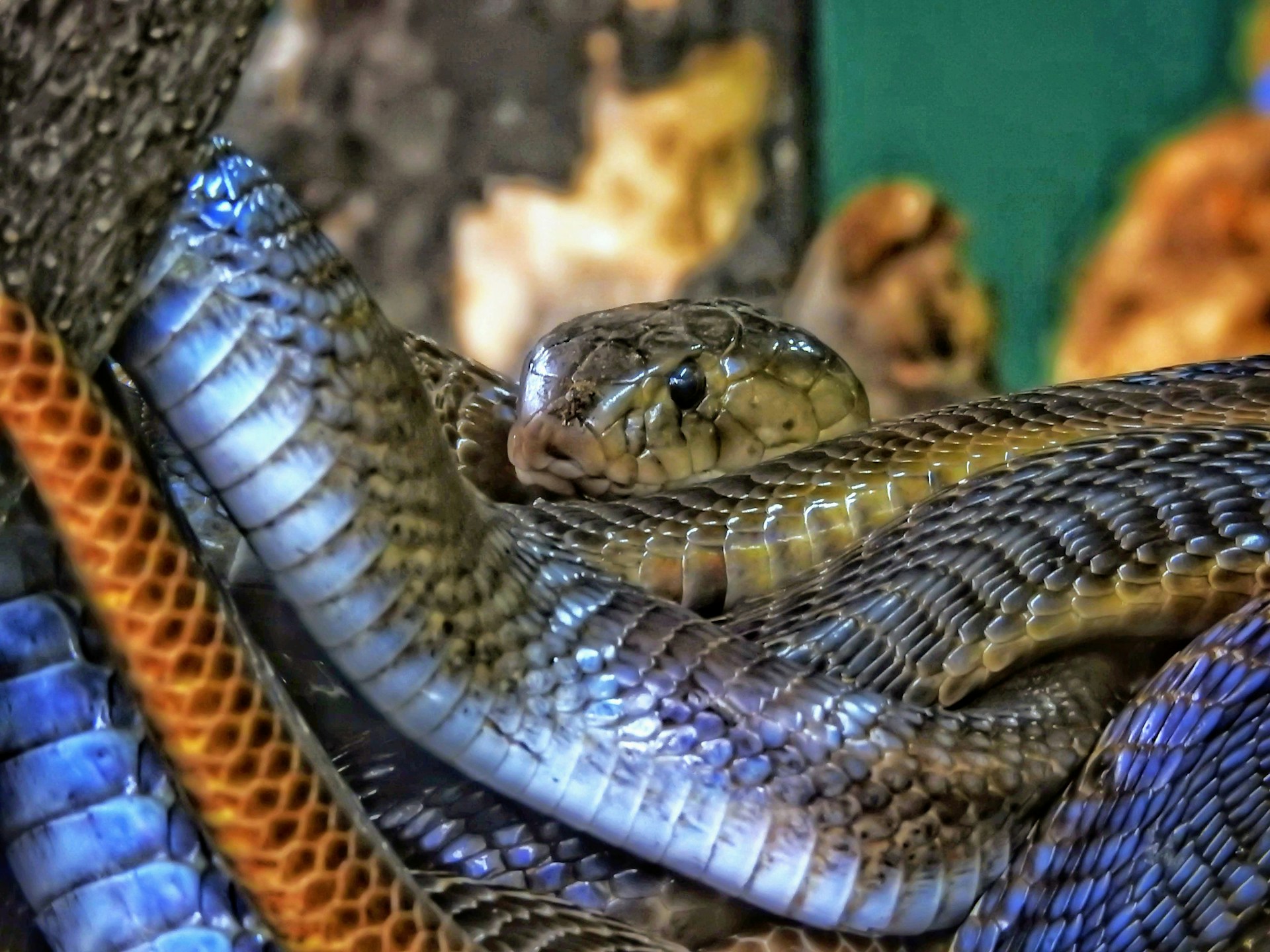When it comes to nature’s most mesmerizing spectacles, few can rival the hypnotic display of a snake that seems to shimmer as it glides across the landscape. This remarkable optical phenomenon isn’t magic or illusion but rather a fascinating combination of specialized scales, light refraction, and evolutionary adaptation. The “shimmering snake” effect has captivated scientists, wildlife enthusiasts, and casual observers alike, offering a window into the complex and beautiful adaptations that have evolved in the reptile world. Beyond its visual appeal, this shimmering quality serves crucial functions for the species that possess it, blending defense mechanisms with hunting strategies in a display that reminds us how extraordinary the natural world truly is.
The Sunbeam Snake: The Ultimate Shimmerer
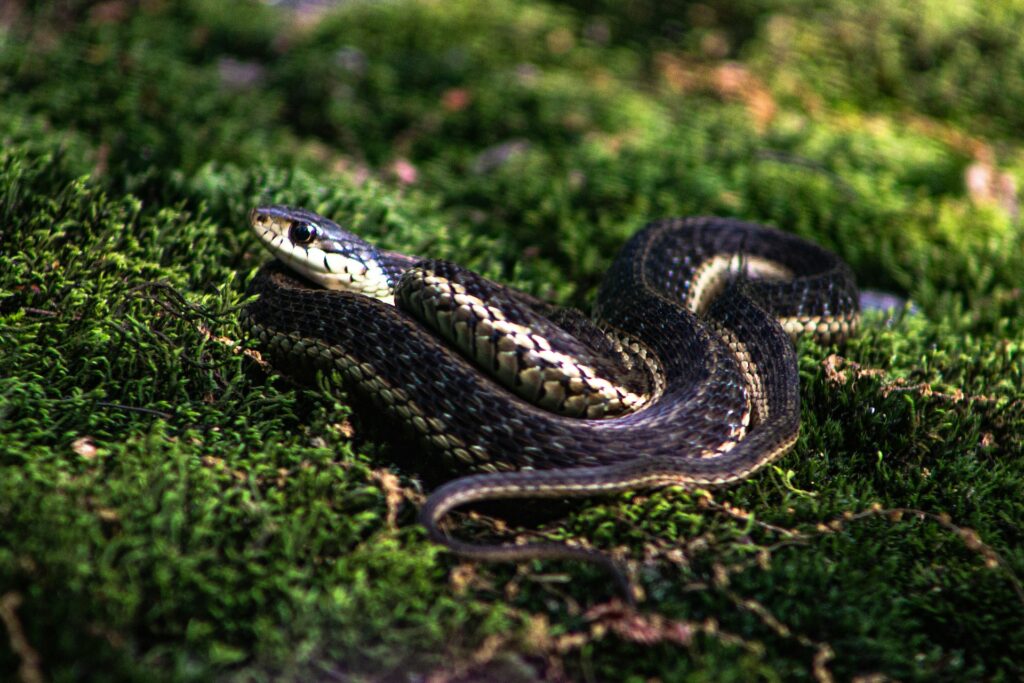
The most famous “shimmering” snake is undoubtedly the Sunbeam Snake (Xenopeltis unicolor), native to Southeast Asia. These non-venomous reptiles possess highly iridescent scales that create a spectacular rainbow effect when they move in the sunlight. The Sunbeam Snake’s polished, smooth scales reflect light in a way that produces a continuous ripple of color along its body, resembling flowing water or liquid metal. Their dark-colored bodies, typically black or dark brown, provide the perfect backdrop for this iridescence to stand out dramatically against the forest floor. Despite their stunning appearance, Sunbeam Snakes are secretive and spend most of their time burrowing underground, making a sighting of their shimmering display a rare treat for those lucky enough to encounter them.
The Science Behind the Shimmer
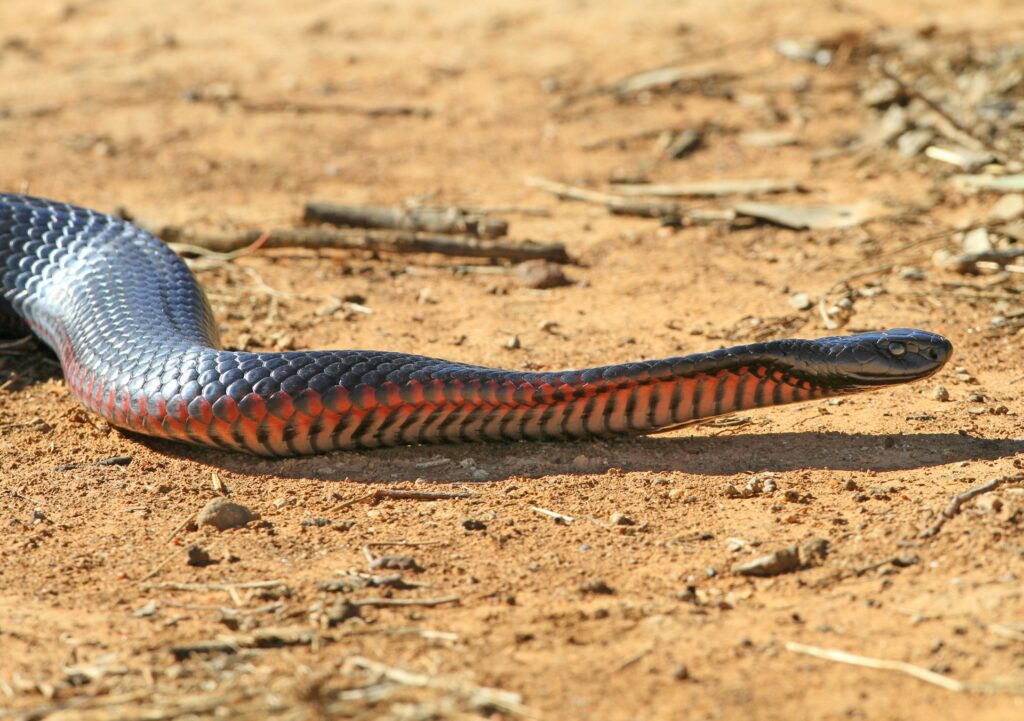
The shimmering effect observed in certain snake species is the result of complex structural adaptations in their scales rather than pigmentation. Unlike color that comes from chemical pigments, iridescence is produced by physical structures that manipulate light through interference, diffraction, and refraction. The scales of shimmering snakes like the Sunbeam Snake contain microscopic ridges and layers that split light into its component wavelengths, similar to how a prism works. As the snake moves, the angle between the light source, scales, and viewer constantly changes, creating the dynamic rippling effect we perceive as shimmering. This phenomenon, known as structural coloration, is the same principle behind the iridescence seen in soap bubbles, certain insects, and bird feathers. Electron microscopy studies have revealed that these scales contain precisely arranged crystalline microstructures that have evolved to manipulate light with remarkable efficiency.
Evolutionary Advantages of Shimmering
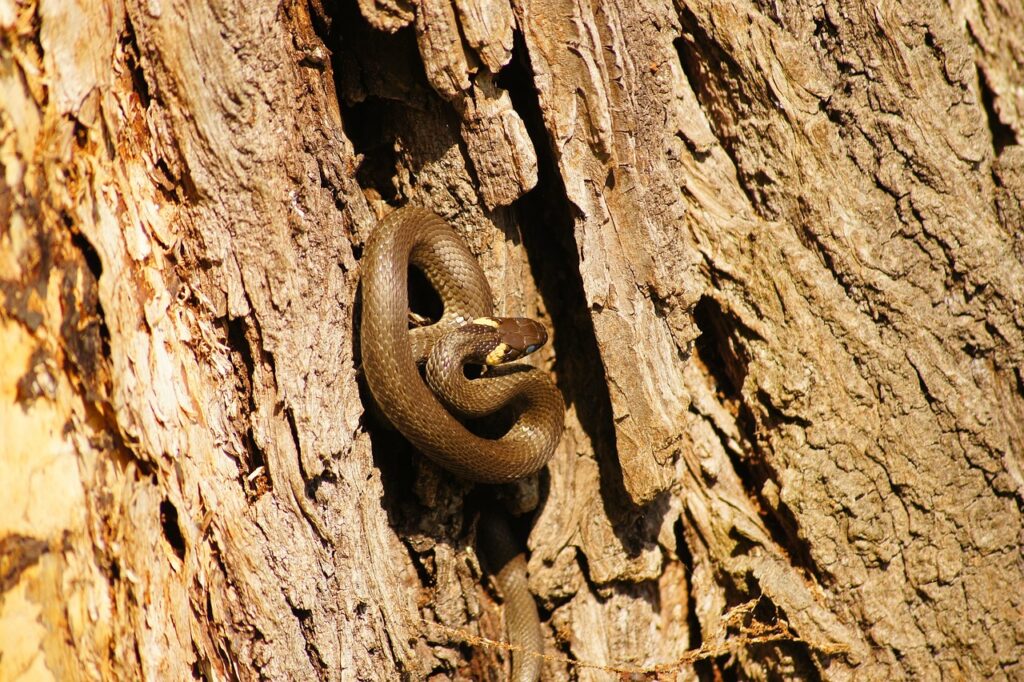
The evolution of shimmering scales serves multiple potential advantages for snakes that possess this trait. For burrowing species like the Sunbeam Snake, the smooth, highly polished scales reduce friction against soil particles, making underground movement more efficient. The iridescence may also function as a form of defensive dazzle camouflage, temporarily confusing predators with flashes of light and color when the snake emerges from its burrow and needs to quickly escape. Some biologists theorize that the shimmer might serve as a warning signal to potential predators, similar to aposematic coloration in venomous species. In darker forest environments, the ability to reflect even minimal light could help these snakes navigate low-light conditions more effectively. The combination of these advantages likely contributed to the natural selection and refinement of the shimmering adaptation over millions of years.
The Rainbow Boa’s Spectacular Display

The Brazilian Rainbow Boa (Epicrates cenchria) presents another stunning example of a shimmering snake. These magnificent constrictors possess scales that refract light to produce a rainbow-like iridescence that seems to dance across their bodies as they move. Unlike the Sunbeam Snake, Rainbow Boas exhibit this quality even in moderate lighting, though the effect is most dramatic in direct sunlight or strong artificial light. Their base coloration—a rich pattern of reddish-brown with black rings—becomes transformed when light hits at the right angle, revealing blues, greens, purples, and golds that appear to flow like oil on water. Rainbow Boas primarily inhabit the Amazon Basin, where their shimmering quality might help them blend into the dappled light of the rainforest floor. Their popularity in the pet trade stems largely from this extraordinary visual characteristic, though proper care requires replicating their specific humidity and temperature requirements.
White-Lipped Pythons: Metallic Marvels
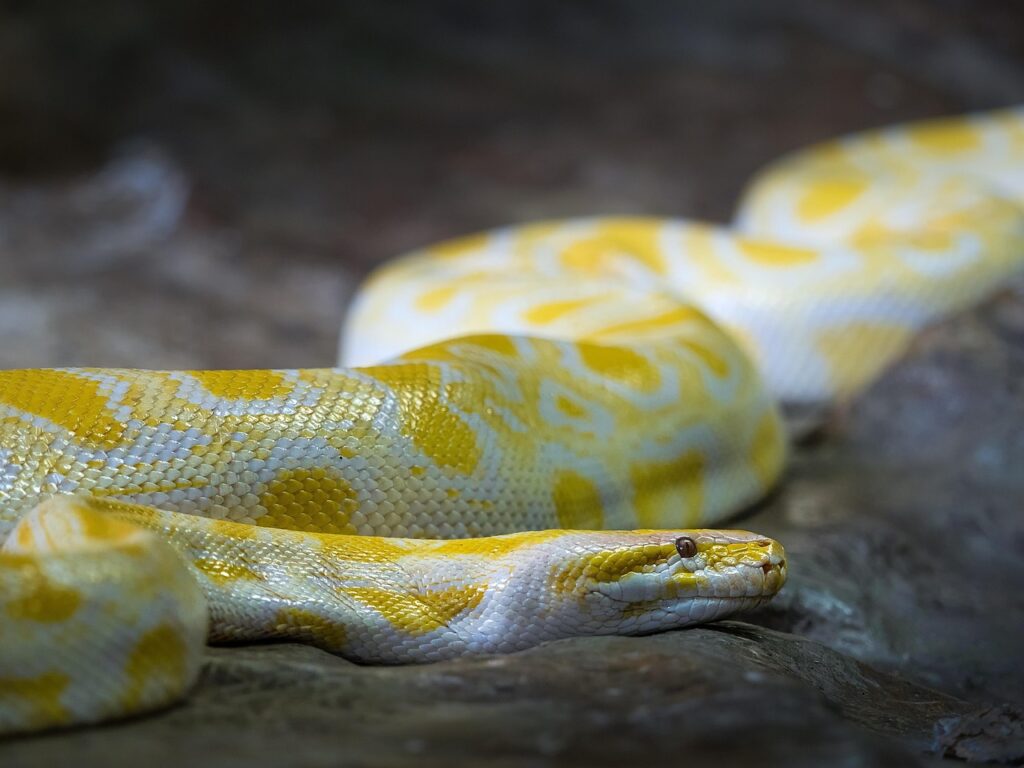
The White-Lipped Python (Leiopython albertisii) from New Guinea exhibits a different type of shimmer that resembles polished metal more than rainbow iridescence. These pythons display a remarkable blue-black body with scales that reflect light in a way that creates a metallic, almost chrome-like appearance when they move. The effect is enhanced by their distinctive white or cream-colored lips that provide stark contrast to their dark bodies. As White-Lipped Pythons move, the light plays across their scales in waves that ripple from head to tail, creating an illusion of liquid metal in motion. They primarily inhabit tropical rainforests where this metallic sheen might help them remain cryptic among wet leaves and streams where similar reflective surfaces occur naturally. The combination of their unusual coloration pattern and reflective properties makes them one of the most visually distinctive python species in the world.
Shimmering as Camouflage
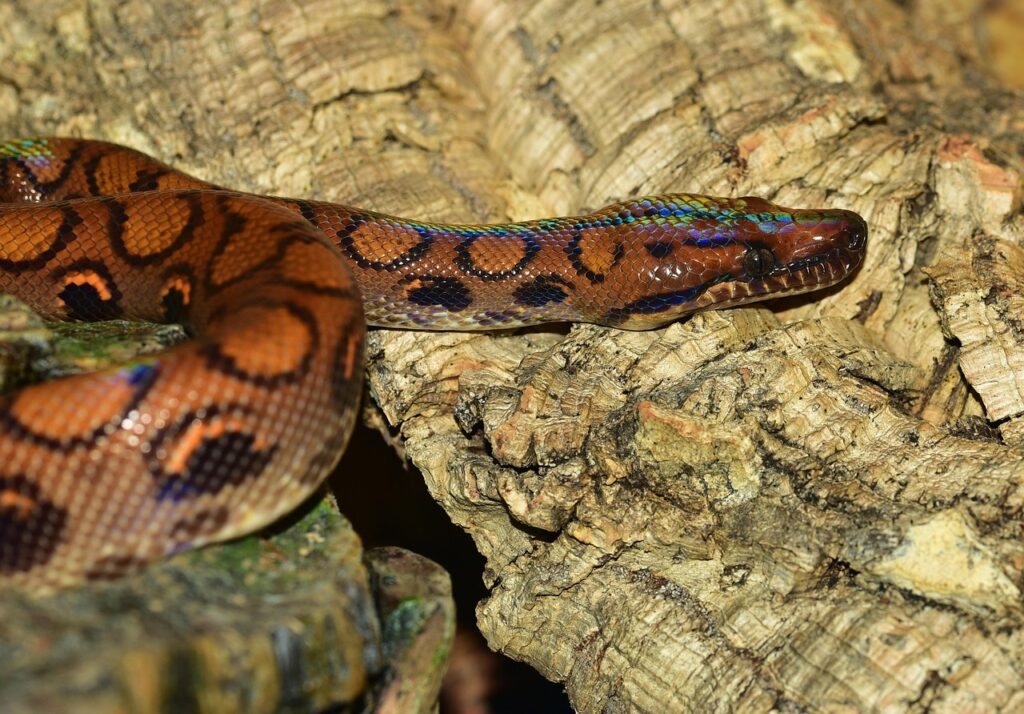
Counter to what might seem intuitive, shimmering scales can actually help snakes blend into their environments rather than stand out. In environments with dappled light, such as forest floors or areas with moving water, reflective scales can break up the snake’s outline and help it match the changing patterns of light and shadow. This type of camouflage, sometimes called “disruptive coloration,” makes it difficult for both predators and prey to distinguish the snake’s shape from the background. The constant slight movement of scales as the snake breathes or adjusts its position creates shifting reflections that mimic the natural movement of light through leaves or across water surfaces. For subterranean species like the Sunbeam Snake, the iridescence may help them match the glistening quality of recently disturbed soil or wet tunnel surfaces. This adaptive camouflage demonstrates how even seemingly showy features can serve protective functions in the right ecological context.
Cultural Significance of Shimmering Snakes
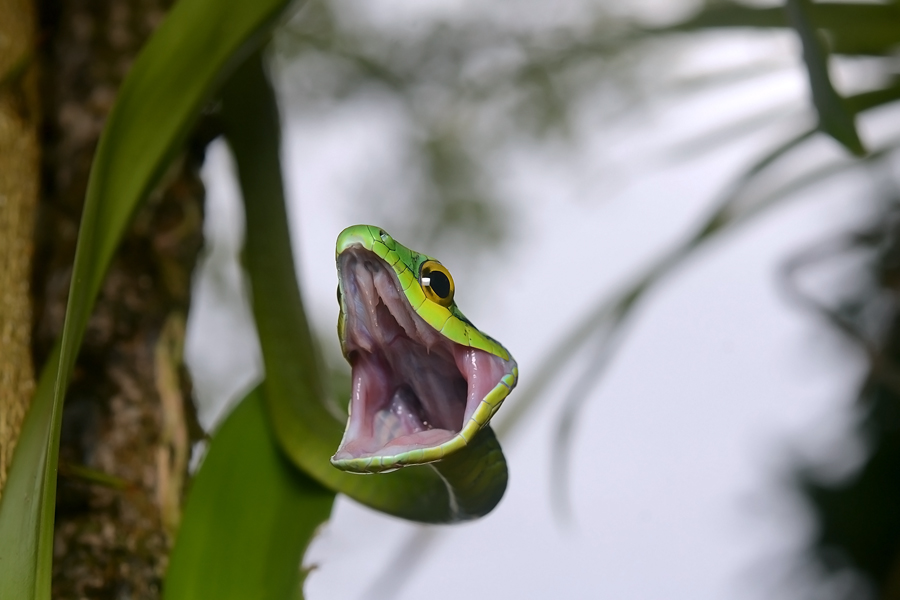
Across various cultures, shimmering snakes have inspired myths, legends, and artistic representations that highlight humanity’s fascination with these unusual reptiles. In many Southeast Asian cultures, encounters with the iridescent Sunbeam Snake are considered auspicious, representing good fortune or divine presence due to their otherworldly appearance. Some indigenous Amazonian communities view the Rainbow Boa as a spiritual entity connected to water and fertility, its shimmering scales symbolizing the connection between earthly and spiritual realms. These cultural interpretations often recognize the magical quality of the shimmer, seeing in it something that transcends ordinary animal coloration. Historical texts from colonial naturalists describe these snakes with wonder and sometimes religious overtones, referring to them as “jeweled serpents” or “living rainbows.” Even in modern times, shimmering snakes frequently appear in art, fashion, and design, inspiring everything from jewelry to fabrics that attempt to recreate their dynamic play of light and color.
Distribution and Habitat Preferences
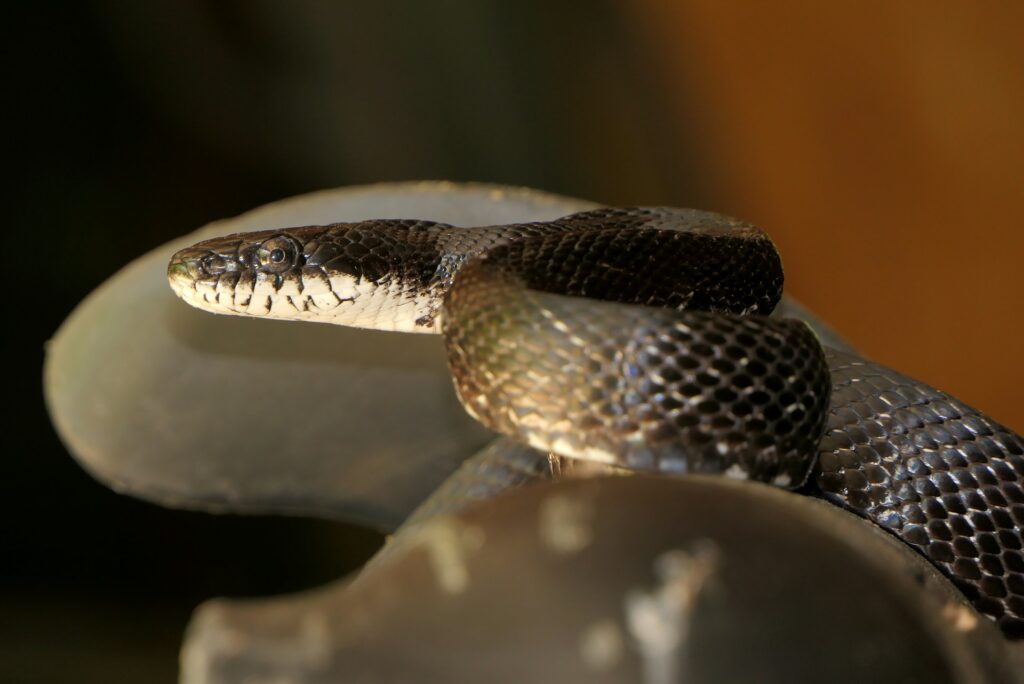
Shimmering snake species are predominantly found in tropical and subtropical regions around the world, with particular concentration in Southeast Asia, South America, and parts of Oceania. This distribution pattern suggests that warm, humid environments may provide optimal conditions for the development and maintenance of iridescent scales. Many shimmering snake species, including the Sunbeam Snake and Rainbow Boa, prefer areas with consistent moisture and moderate to high humidity, which helps preserve the reflective properties of their scales. Habitat preferences vary by species, with some favoring forest floors rich in leaf litter where they can burrow, while others may inhabit more diverse terrain including grasslands with loose soil. Interestingly, few desert-dwelling snakes exhibit pronounced iridescence, possibly because the harsh, abrasive sand and intense UV exposure would damage the delicate microstructures responsible for the shimmering effect. The specialized habitats required by these snakes make many shimmering species vulnerable to habitat destruction and climate change effects.
Reticulated Python’s Subtle Shimmer
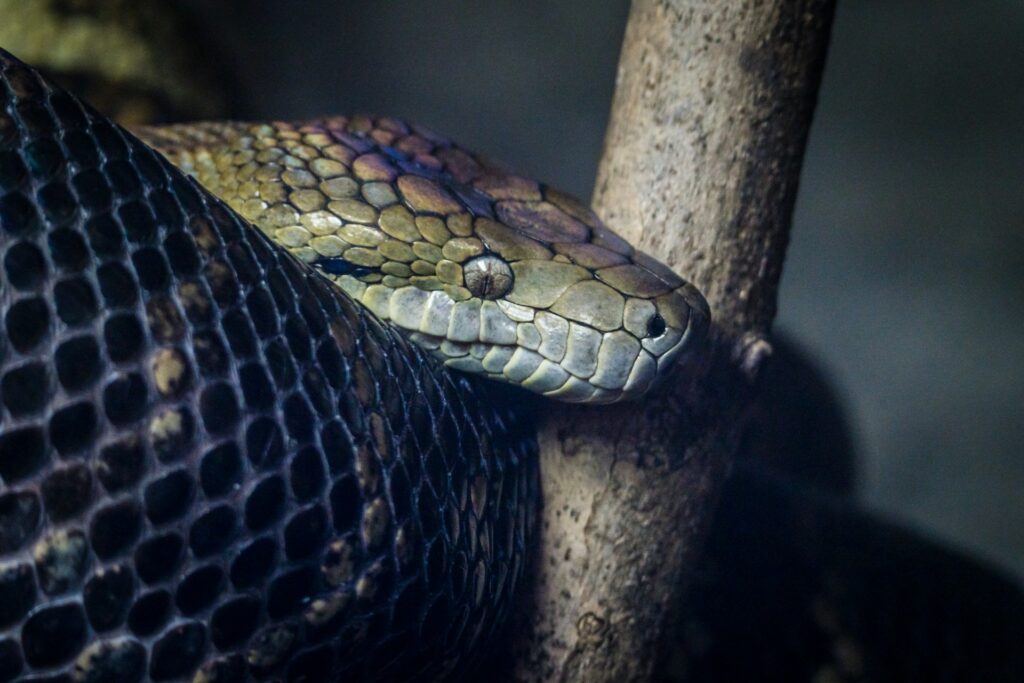
The Reticulated Python (Python reticulatus), among the longest snakes in the world, exhibits a more subtle but still impressive shimmering quality. Unlike the dramatic rainbow effect seen in some specialized species, reticulated pythons display a more understated iridescence that enhances their complex pattern of geometric markings. This subtle shimmer becomes apparent when light strikes their scales at certain angles, adding depth and dimension to their already intricate coloration. The effect is most noticeable in healthy specimens with recently shed skin, when their scales are at their cleanest and most reflective. Wild reticulated pythons inhabiting the rainforests of Southeast Asia may use this subtle light-reflecting quality to better blend into the varied light conditions of their forest habitat. The combination of their complex pattern and light-reflecting properties creates a camouflage that works effectively whether the snake is resting among tree roots or moving through patches of forest light.
Observation Challenges and Photography
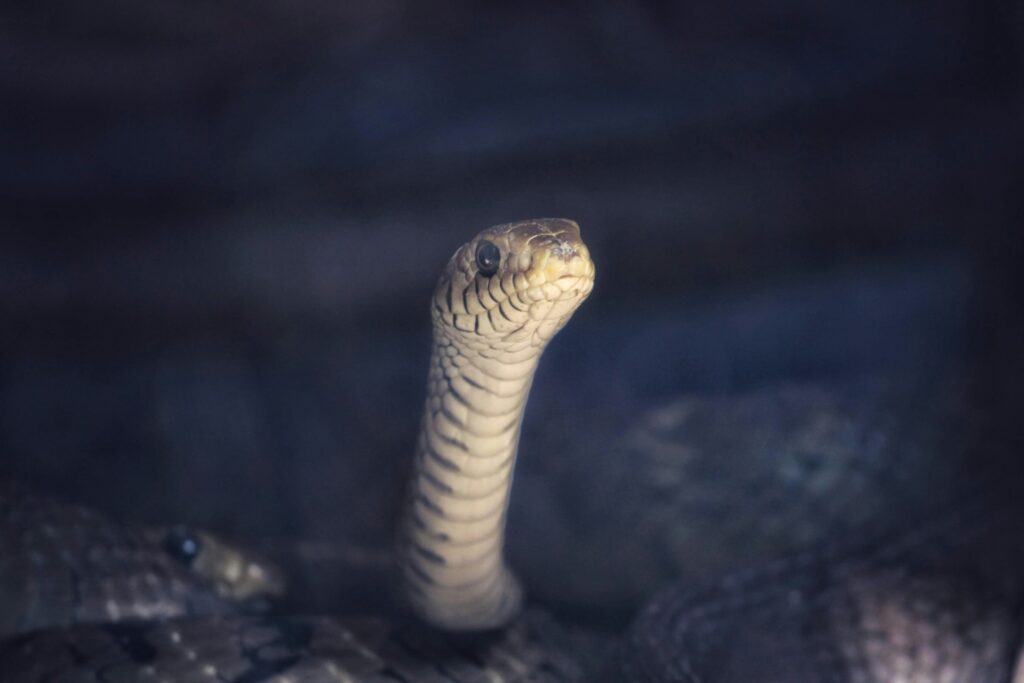
Capturing the shimmering effect of these remarkable snakes presents unique challenges for both observers and photographers. The iridescence is often angle-dependent, meaning it may only be visible from certain viewing positions relative to the light source and the snake itself. Wildlife photographers seeking to document this phenomenon must understand the physics of light reflection and position themselves accordingly, often trying multiple angles and lighting conditions. Standard photography equipment may struggle to accurately capture the dynamic nature of the shimmer, as it changes constantly with the snake’s movement. Advanced techniques including polarizing filters, specific lighting setups, and high-frame-rate video can help better document the effect. For field researchers and casual observers alike, patience becomes essential as the shimmer may only become apparent during brief moments when all factors align perfectly. This elusiveness adds to the mystique of shimmering snakes and makes successful documentation of their iridescence particularly rewarding.
Conservation Concerns
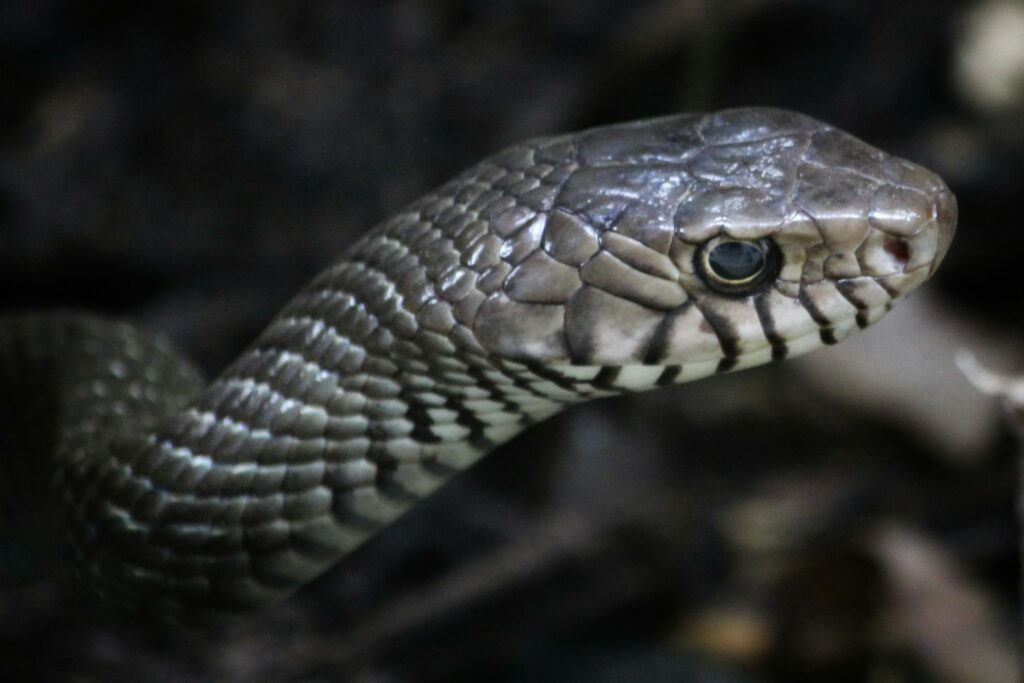
Many shimmering snake species face significant conservation challenges in the wild due to their specialized habitat requirements and, ironically, their visual appeal. The pet trade has placed particular pressure on species like the Brazilian Rainbow Boa, with wild collection depleting some local populations before sustainable captive breeding programs were established. Habitat destruction presents perhaps the greatest threat, as many iridescent species require specific forest conditions that are rapidly disappearing due to agricultural expansion, logging, and development. Climate change impacts, including altered rainfall patterns and increasing temperatures, may affect the microhabitats these specialized reptiles depend upon. The Sunbeam Snake, despite not being officially listed as endangered, faces localized threats throughout its range in Southeast Asia where rapid development is transforming its forest habitat. Conservation efforts focused on habitat preservation and regulated trade are essential to ensuring these living jewels continue to shimmer in the wild for generations to come.
Caring for Shimmering Snakes in Captivity
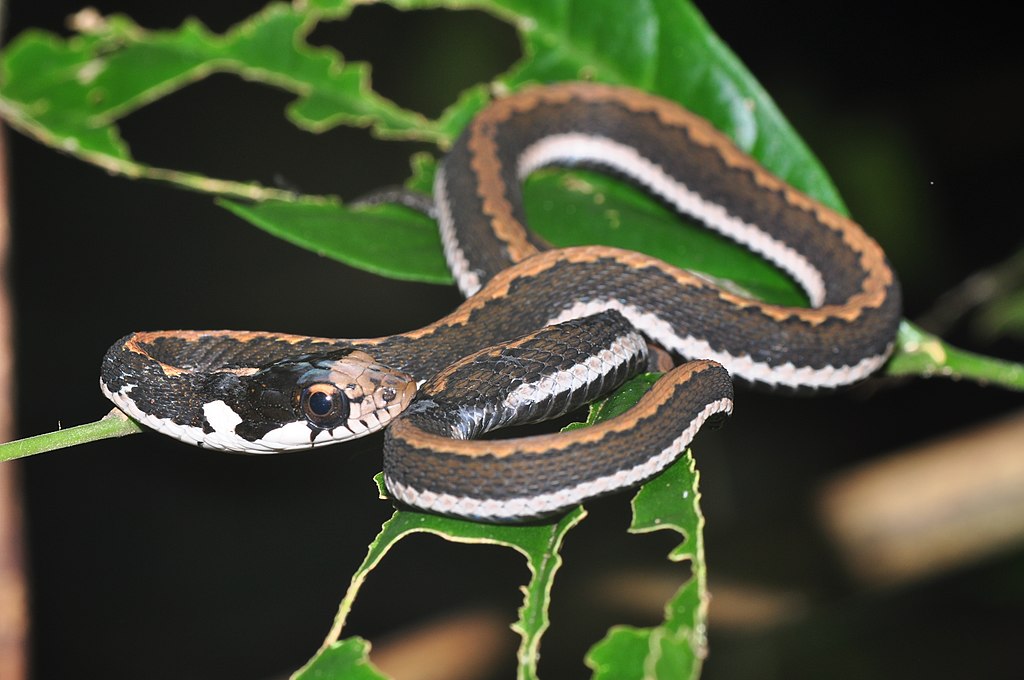
Maintaining the health and spectacular appearance of shimmering snakes in captivity requires specialized care focused on recreating their natural conditions. Humidity control is paramount, as proper moisture levels help facilitate healthy shedding that preserves the microstructures responsible for their iridescence. Enclosures should include appropriate substrate that allows for natural burrowing behaviors without being abrasive to their specialized scales. Lighting must be carefully considered, with some keepers installing full-spectrum lighting that not only supports the snake’s biological needs but also enhances the visibility of their iridescent display. Diet requirements vary by species but generally include appropriately-sized rodents and, for some species, birds or other prey items that provide the necessary nutrition to maintain healthy skin and scales. Regular, gentle misting helps many shimmering species maintain proper hydration and scale condition, particularly important during shedding periods. Ethical keeping practices emphasize acquiring only captive-bred specimens rather than wild-caught individuals, supporting conservation while ensuring healthier, better-adapted pets.
Future Research Directions
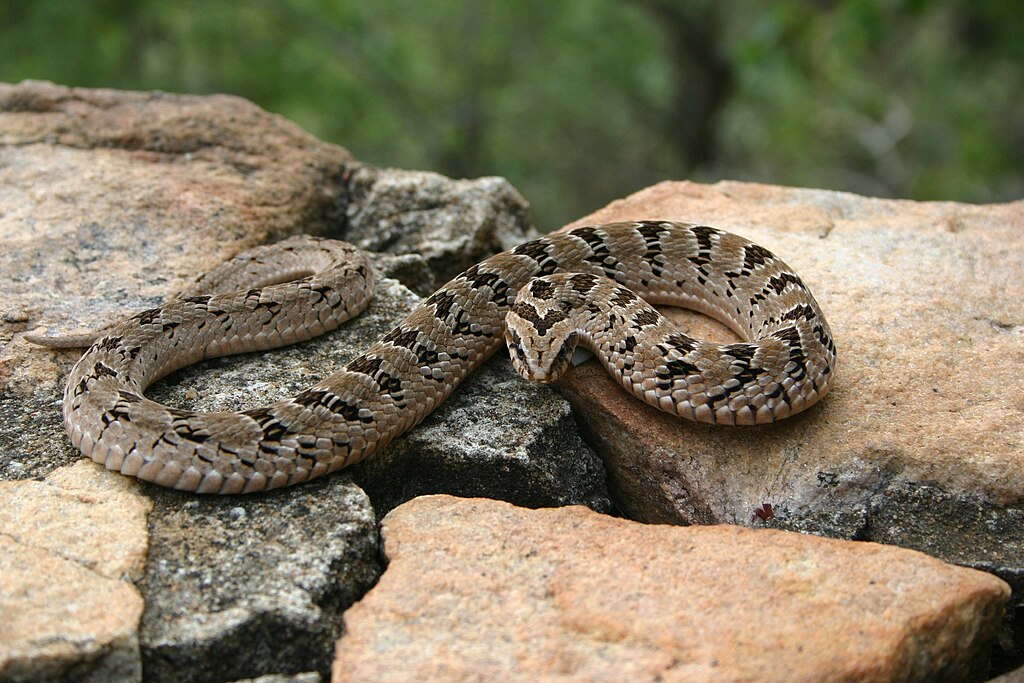
The phenomenon of shimmering snakes continues to inspire scientific inquiry across multiple disciplines. Biomimicry researchers are studying the microstructure of iridescent snake scales to develop new materials with similar light-manipulating properties, potentially leading to applications in optics, anti-counterfeiting technology, and sustainable design. Evolutionary biologists are working to better understand the genetic basis for iridescence and how it evolved independently in different snake lineages, offering insights into convergent evolution and adaptation. Advanced imaging technologies promise to reveal more details about how these scales function on a microscopic level and how they might be influenced by environmental factors. Climate change researchers are monitoring how altered conditions affect the development and maintenance of iridescent features in wild populations. As technology advances, our understanding of these remarkable reptiles will likely deepen, potentially revealing new species or subspecies with unique shimmering characteristics that have yet to be fully documented or understood.
Conclusion
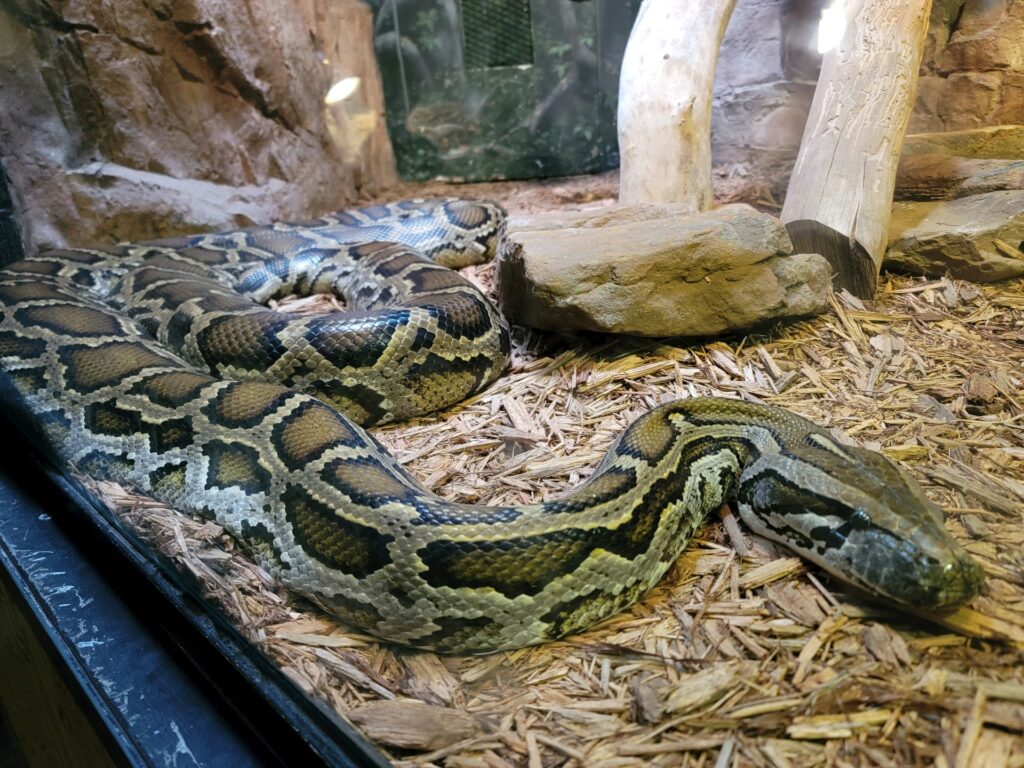
The shimmering snake represents one of nature’s most captivating visual displays, combining complex physics with evolutionary adaptation to create living art that moves through our world’s forests and jungles. From the dramatic rainbow ripples of the Sunbeam Snake to the subtle metallic gleam of larger pythons, these reptiles demonstrate the extraordinary diversity of strategies life has developed to survive and thrive. Their iridescence serves multiple purposes, from practical burrowing assistance to sophisticated camouflage and potential warning signals. As we continue to study and appreciate these remarkable creatures, they remind us that even in animals often misunderstood or feared, nature has created beauty of extraordinary complexity. Protecting the habitats these specialized reptiles depend on not only preserves biodiversity but also safeguards one of the animal kingdom’s most mesmerizing optical phenomena for future generations to discover and admire.

